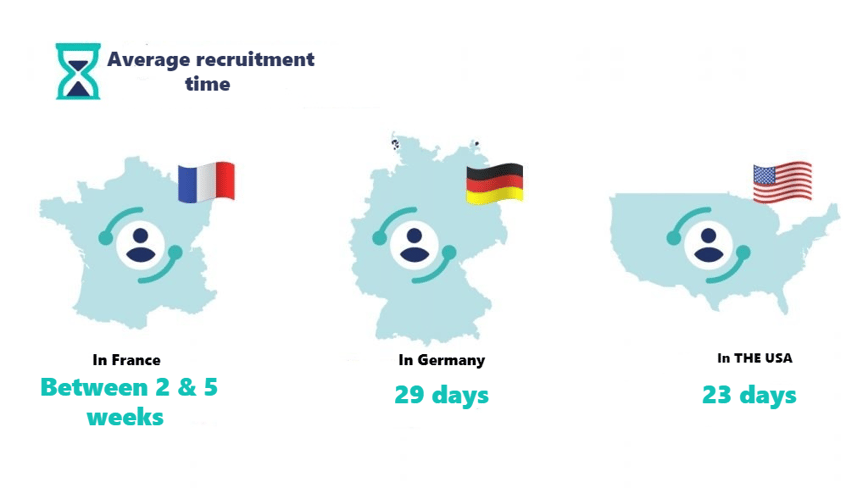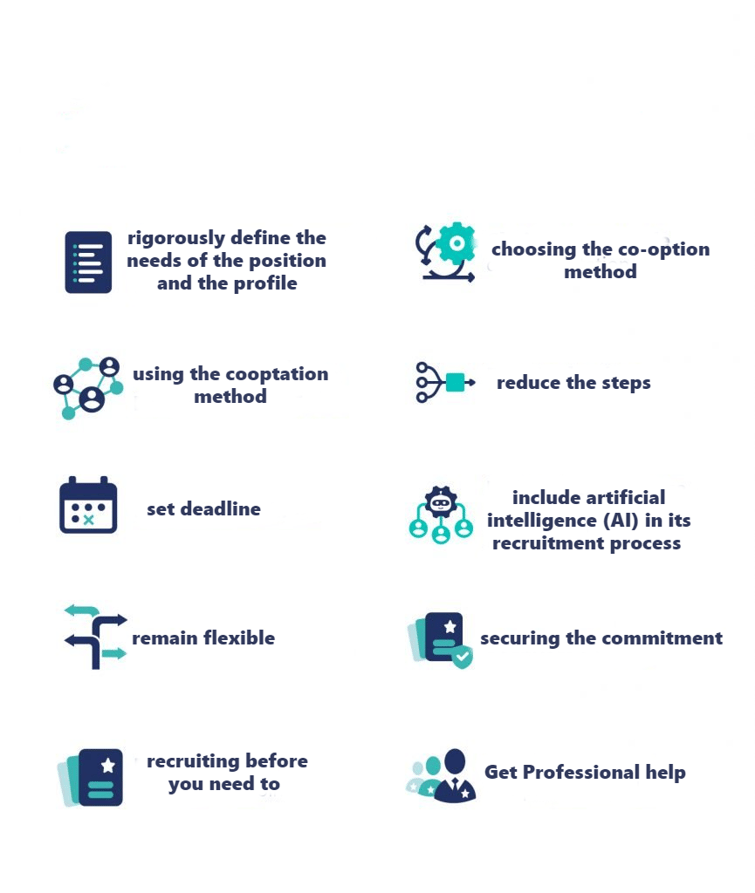A long recruitment process affects the employer's image and is costly. Furthermore, a long recruitment process doesn't necessarily mean you're recruiting the right candidate. Rather, if candidates are not eager to hear the final decision, they are probably less interested. There is also the risk that the recruiter will select a candidate out of spite.
Accelerating the recruitment process must therefore be an HR priority. Here are 10 tips to achieve this.

Indeed, there are many issues at stake. A long process affects the employer's image and is costly. Moreover, a long recruitment process is not necessarily a sign that the candidate recruited will be the right one. On the contrary, if a candidate is not impatient to know the final decision, it means that he is probably less interested. Another risk of a long process is that the recruiter finally selects a candidate out of spite.
Accelerating the recruitment process must therefore be an HR priority. Here are 10 tips to do so

1. Rigorously define the job requirements and the profile
Recruiting takes time when you haven't clearly defined your expectations. You need to draft a relevant job description as accurate as possible to avoid irrelevant applications. This prevents you from wasting time evaluating profiles that don't fit the company's needs.
You should also establish the profile of your ideal candidate, the recruitment persona, and prioritize the selection criteria. Finally, a clear definition of the position and the profile will give you a first clue on the niche where your recruiting will have the best chances to succeed.
This will save you time on 3 levels:
- fewer non-compliant applications,
- less sorting of applications by determining a typical candidate profile
- productive recruiting.
2. Using the cooptation method
The recommendation or cooptation system is usually more effective and faster, than any other recruitment system. In fact, it happens through an intermediary that both parties (the company and the potential candidate) trust.
The recommender doesn't want to risk recommending the wrong profile and the recommended candidate wants to live up to the recommendation. The turnover rate is very low and doubles the recruitment time. Moreover, the cooptation system avoids having to go through all the long stages of recruitment: sourcing, selection, interviews of several candidates.
The cooptation system can also be automated. To do this, you must build a computerized system of recommendations and notifications on social media and professional networks. For example, you can be notified when a suitable profile appears.
3. Involve the right people from the start
Constantly going back and forth between the HR department and others involved in the recruitment effort makes the process longer. Therefore, it's important to identify all the parties to involve from the start, defining those whose opinion is absolutely required and those whose opinion is only advisory. Collegiality or too much hierarchical validation tends to increase the duration of the recruitment process tenfold. Waiting for feedback takes time. The best approach is to stick to a small team that can make and handle decisions. You can then set up weekly meetings or alert systems whenever their feedback is required.
4. Shorten the steps
In recruitment, "less is more" is also a rule to follow. You should define the steps candidates must go through prior to the recruitment process. Moreover, keep them informed of the different steps.
Don't increase the number of tests and interviews, because if you are not convinced by a candidate, then it's probably because they are not the right person. Furthermore, only 48% of candidates are willing to attend a second interview. If you set up a third interview, you are more likely to discourage and tarnish your image than to make a qualified recruitment. Be sure to have an evaluation grid based on your prioritized criteria and stick to it.
5. Set deadlines
It may seem trivial, but you can speed up your recruitment process by simply setting deadlines for each step: time for sourcing, screening and final decision-making. Similarly, you should set a deadline for the interviews and organize them at approximately the same time to avoid having too much time between two interviews. This will avoid wasting time and spreading yourself too thin.
6. Use artificial intelligence (AI) in your recruitment process
New technologies are reducing time in many areas, including recruiting. Use Artificial Intelligence (AI) in your recruiting system to speed up the process, especially in the pre-screening stage. Furthermore, AI is a great alternative during the current health crisis, as it limits human contact and face-to-face assessment. Large companies such as L'Oréal and Amazon are already using AI. AI can be used to identify keywords in resumes and cover letters to analyse language and vocabulary. AI can also be used to decode non-verbal language in video interviews. It is also integrated in many ATS (Applicant Tracking System) available today.
7. Stay flexible
The market reality nowadays forces you to be flexible in your recruitment. You can't get it all and you have to accept to recruit a profile that doesn't match 100% of your criteria. We must not fall into what HR experts call "the curse of the perfect candidate". Once again, prioritizing selection criteria is essential. Which soft-skills are absolutely needed? Hard-skills deficiencies can always be corrected by onboarding training. Changing personalities is more complicated.
8. Secure commitment in the recruitment process
One of the factors that lengthens the duration of a recruitment is the loss of a good candidate along the way. The profile may be lost because of a bad candidate experience and your image may be affected. There is also the risk of resigning within the first few months of employment, which leads to high turnover. One tip to speed up the recruitment process is to secure the candidate's commitment: listen to the candidate's expectations to improve the experience, communicate regularly and effectively with the candidate and provide quality onboarding.
9.Recruit before you need to
The best way to speed up the recruiting process is to have candidates to recruit within the company without having to post job offers. To do this, you need to plan for jobs and skills by anticipating recruitment.
Recruiting work-study students or interns increases your chances of finding a good candidate tenfold. You recruit them well before your needs emerge and train them. Once the need arises, you formalize their contract (which was previously an internship, apprenticeship or professional training contract). This system allows you to save time, but also to control the costs of recruitment and to claim the aids and exemptions offered by the government for this type of recruitment.
10. Get help from professionals
Finally, using recruitment professionals also helps speed up the process. Not only do they have access to a larger pool of talent in the target field, they also have all the tools to recruit well and quickly.
Recruit with Hunteed to speed up your recruitment process:
Hunteed optimizes your recruiting time. This online recruitment platform provides all the tips mentioned in this article. Hunteed works with companies to carefully define the position's requirements and all the internal staff to involve. The recruitment process is carried out by recruitment experts. Companies benefit directly from these professionals' talent network and expertise. Recruitment takes less time and is more efficient. Hunteed's online platform uses relevant new technologies such as ATS. It provides a professional commitment guarantee (against turnover) and ensures a high quality candidate is recruited.















 ENGexpand_more
ENGexpand_more  FR
FR